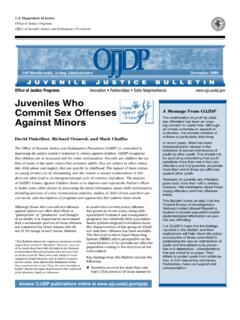Transcription of Prevention and Reduction: A review of strategies for ...
1 Research Report DFE-RR111 Prevention and Reduction: A review of strategies for intervening early to prevent or reduce youth crime and anti-social behaviour Andy Ross, Kathryn Duckworth, David J. Smith, Gill Wyness and Ingrid Schoon Centre for Analysis of Youth Transitions (CAYT) This research report was commissioned before the new UK Government took office on 11 May 2010. As a result the content may not reflect current Government policy and may make reference to the Department for Children, Schools and Families (DCSF) which has now been replaced by the Department for Education (DFE). The views expressed in this report are the authors and do not necessarily reflect those of the Department for Education.
2 Table of Contents Executive 1. Boundaries to the The logic of Quality of 2. International Previous Individual focused Family focused School focused Prevention in the community What doesn t work?..35 3. Tackling Youth Crime in An overview of the youth crime Prevention Individual centred and family based School based Community and neighbourhood based early intervention 4. Key themes emerging from the Evaluation Targeting the 5. Implementation and going to 6. Summary and Final The youth crime landscape: Panacea or patchwork?..73 7. 1 Executive summary Background This review is aimed at providing a comprehensive understanding of the key characteristics of what works in terms of early interventions to prevent or reduce youth crime or anti-social behaviour.
3 By drawing on evidence from the international literature, primarily the US where the evidence base is especially strong, we are able to provide a critical evaluation of youth crime interventions in England, where the scientific evidence is less robust. This collation of the best evidence and expert opinion will support the development of the strongest and most promising approaches. At the same time we identify gaps in the evidence and make recommendations for further research. This report consists of two separate although interrelated parts. The first examines the international evidence, predominantly from the US, where the extent and quality of evidence is especially strong.
4 Here we review some of the primary evaluative literature examining the evaluations of specific interventions, but for the most part the review draws heavily on the reviews or meta-analysis of other authors. The second part focuses specifically on current or recent policy in England, examining evaluations that have been carried out here. Although these are fewer in number and some significant investigations will not conclude until later this year, there is nevertheless a steadily growing literature examining the effectiveness of recent Government policy in this area. The approach enables us to gain a better understanding of the types and characteristics of effective early intervention from the international literature, which we then apply to England to make a critical evaluation of policy where the quality of evidence sometimes falls short.
5 The ultimate result of both parts is a greater understanding of both the types and characteristics of early interventions that work in reducing and preventing youth crime and anti-social behaviour. Scope We are not here concerned with programmes that target infants and very young children with the aim of improving outcomes on a whole range of dimensions: those have already been discussed in the Allen review . Instead, we are concerned with programmes and practices for which the primary aim is to have an impact on the development of antisocial and criminal behaviour in young people aged 8 and above. Quality of evidence Pivotal to any review of interventions aimed at changing young people s behaviour is the quality of the evidence used to assess whether these interventions do in fact work.
6 The interventions and characteristics of interventions that are presented as 2working in this review are based on the most scientific and rigorous methods of evaluation. In order to be considered as working, these programmes have been shown to work in at least two evaluations which incorporate a well defined control group to test what would have happened if there had been no intervention, with a very similar group of individuals. International evidence In a broad ranging meta-analysis examining interventions for reducing youth reoffending, four key characteristics were associated with programme effectiveness: The methods used to evaluate early intervention programmes.
7 Generally this is a forewarning against reliance on poorly designed evaluations which tend to overstate programme effectiveness. The Intervention type and mode. Interventions that embody therapeutic philosophies aimed at nurturing a positive change in young people, and in particular those employing cognitive behavioural techniques, are the most effective overall. Those based on strategies of control or coercion on surveillance, deterrence , and discipline are far less effective and in some cases can actually make matters worse. Quality of programme implementation. This was so important that a less effective but well implemented programme could out-perform a more effective programme that was poorly implemented.
8 The characteristics of the juveniles being treated. Interventions targeted at individuals already manifesting problematic behaviours or demonstrating many of the risk factors associated with the development of offending behaviour are more effective than universally applied programmes. There is evidence that programmes which employ a multi-modal design where a broad range of interventions are applied attending to a multitude of different risk factors are more effective. However they only work where there is also a dedicated case worker present to oversee and coordinate programme delivery. Most of the interventions that have been shown to be effective share most (if not all) of the characteristics identified above.
9 Among programmes aimed at the individual, one type of programme stood out as effective: Child skills training which aims to teach children social, emotional, and cognitive competence by addressing appropriate effective problem solving, anger management and emotion language. Best Practice: Child skills training is especially effective when applied to smaller (more manageable) class sizes, employs cognitive behavioural techniques of instruction and is targeted at older and high risk young people. Within family focused Prevention , the following programmes were found to be effective: 3 Behavioural parent training (BPT) which teaches parents to be consistent in reinforcing helpful behaviour and punishing or ignoring hostile or unco-operative behaviour.
10 Best practice: BPT is more effective in smaller (more manageable) class sizes, and when aimed at parents of older young children (approximately aged 10 and above). Multisystemic therapy (MST) which is an intensive, individualised, home-based therapeutic intervention for high risk juveniles. Depending on the young person s needs MST could include child skills training, parenting training, measures aimed at reducing a young person s association with deviant peers, and measures for improving academic performance and attachment to school. Best practice: There is evidence of increased effectiveness when there is strong adherence to the original programme design.















